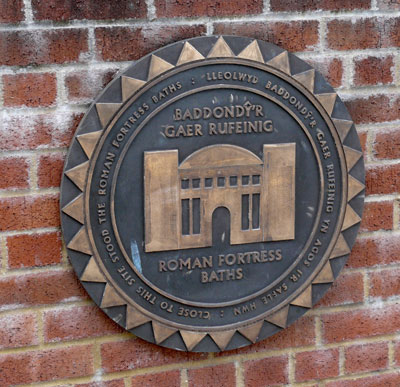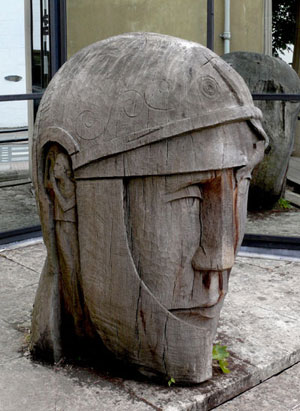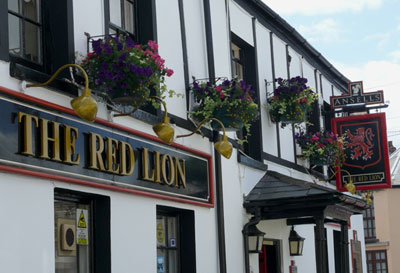CAERLEON, WALES – In a land full of sweet surprises, this tiny village may be the sweetest of them all.
"Caerleon is beautiful."
"Caerleon may be the loveliest village in all of Wales."
"If you’ve not seen Caerleon, then you’ve not seen Wales."
With that kind of prompting from the Welshmen we met at the Celtic Manor Lodge, the ultra-modern resort in nearby Newport and host of the 2010 Ryder Cup of golf, we soon find ourselves in a taxi taking the short 10-minute ride from the hotel to the tiny hamlet that has played a major role in the history of Wales.
The taxi driver deposits us in front of the only modern building in town – the Roman Museum, which holds a treasure of artifacts dating back to the time the Romans set up a legionary fortress here.
The ancient Roman Road, which lead to London, cut directly through this charming village of bake shops, beautiful inns, lovely flower-filled cottages, charming streets lined with neatly-kept shops, a serious collection of pubs and stately Saint Cadocs, a 6th century church which sits opposite the museum and whose tree-filled courtyard is dominated by tumbled tombstones.


Above: Historic markers and clever statues indicate where the Romans like to hang out in Caerleon.
While small, the museum holds a wonderful array of Roman artifacts dug up by archeologists around a town known as Isca in Roman Britain times – between 75 AD and 300 AD.
Emerging from the quaint museum after our mesmerizing visit, the sight of two Roman soldiers dressed in full battle gear makes us think we’ve been transported back to the time the Romans set up their fortress, of castra, here to house the Second Augustan Legion.
A local policeman sees the surprise on our face and comes to our rescue.
"They’re not real Roman Legionnaires," says the officer who can barely contain his laughter. "They are having a re-enactment today at the amphitheatre down the road, right next to the remains of the Roman barracks."
The variety of Roman remains one sees in Caerleon – the name is derived from the Welsh for fortress – is unparalleled in this charming land of dragons and myths. And the fact the Romans built an amphitheatre as well as baths here, indicates that these troops were indeed the elite of Caesar’s army.
The amphitheatre is one of the best preserved in Britain and after paying a small entrance fee, we join locals cheering on a group of children who are about to do battle with a paper dragon. In Roman times, the stadium would have seen fierce battles between gladiators and beasts and the amphitheatre floor would have been blood soaked.
Actors in period costume man tents set up for the re-enactment and explain to visitors what times were like here under Roman rule.

Above: The Red Lion is the place where Spanish golfers are in town for international events.
Ben, a man dressed in the uniform of a Roman officer, tells us that this tiny town has played a major role throughout Welsh history and that two Christian martyrs, Julius and Aaron, met their demise here.
"Oh, and St. David (Wales’s patron saint) made his headquarters here for a short time and best of all, Caerleon was the site of King Arthur’s court," says Ben, who, seeing the shock and awe on our faces, quickly adds, "historians even speculate that our Roman amphitheater may have actually served as King Arthur’s Round Table."
Wow, we thought we were just going to spend a day exploring a small village but we quickly discover we’ve arrived at the crossroads of British history.
Ben also tells us that his town was the scene of many fierce battles between the Welsh and Normans and that the small village was actually more important than medieval capitals like Canterbury or York during its heyday.
The Roman ruins actually stood the test of time until about 1217 when they were demolished and reused in building of the town’s castle.
Only the foundation of the Roman barracks is visible as we arrive at the spot where hundreds of Roman legionnaires would camp for the night. Children run on the blackened stone foundation which once held up the impressive barracks, and lovers embrace on the mounds of grass that have grown up around the rooms where the legionnaires slept or polished their armour.
All this Roman history has worked up our appetite so we retreat back into the centre of this town built around small Goldcroft Common - the only one left of the town’s original seven. When we arrive at the intersection of High Street and Cross Street, an area known locally as The Square, we are impressed by a large stone structure with a sign indicating that this is the Priory Hotel and Restaurant.
Stained glass windows and some antique furnishing we see through the arched entrance lures us inside the historic building which, a bartender tells us, served as a Cistercian monastery back in the 12th century and later a nunnery. Rare glass medallions surround the nun’s court where a wedding is being held on the day we visit and ornate oak panels and lovely stained glass from 1622 surround us in the Oak Panel Room where we order up fish and chips and wash it down with a pint of the local brew. Our young Korean server reminds us that old Caerleon keeps a youthful appearance thanks to the presence of students who attend a campus of the University of Wales situated in this storehouse of history. Many, like our server Kim, take jobs at the local restaurants and pubs to underwrite tuition costs.
Kim suggests - “since you’ve come all this way” - we should not miss the Roman baths, located directly across the street from the Priory, which offers 22 beautifully decorated rooms wrapped in a blanket of ancient history.
While no Bath – Caerleon’s much larger English cousin about an hour’s train ride away – the Roman baths found here are still impressive and the visitor’s centre recently completed over the Roman remains offers a wonderful interactive display that delights visitors.
While wandering the streets afterwards, we try and keep count of the pubs we come across and give up when we reach 12 – and that was just around the Square. Many of the town’s pubs are located along the banks of the River Usk which flows through town. The Bolero pub, where country music drifts out the front door, is reportedly where Spanish golf stars like Sergio Garcia like to hang out when they come to play the Celtic Manor’s PGA-ranked golf course, the Twenty-Ten, which is where the 2010 Ryder Cup will be played.
Caerleon is a now village of artists who create masterful works out of tree stumps. Many of the pieces are scattered around the town centre but the best collection can be found in a narrow lane off High Street called the Ffwrrwm, which leads to a small specialist shopping courtyard, restaurants and an eclectic display of wood sculptures.
On the taxi ride back to the Celtic Manor, the driver suggests we may want to visit Caerleon’s sister village, Caerwent, the first town of Wales and another place that harkens back to Roman times. “It’s just as lovely as Caerleon,” says the driver.
“Nothing can be as lovely as Caerleon,” we tell the driver, who agrees and turns into the Celtic Manor’s driveway, thus ending our short trip back in time.